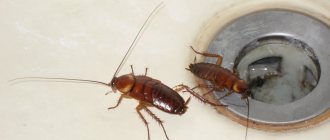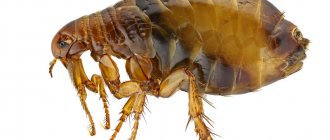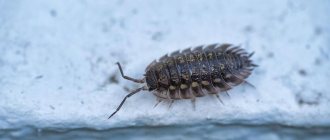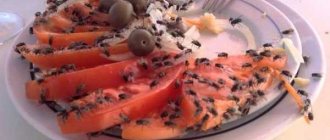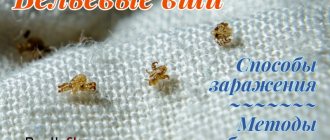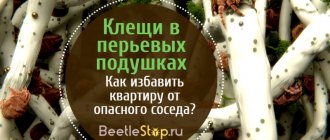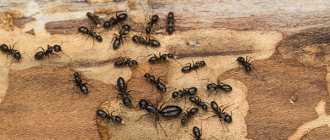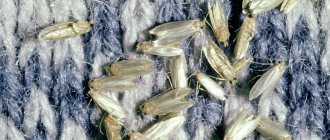Drosophila flies are quite annoying with their presence in people's homes, despite the fact that they do not bite, do not carry dangerous diseases and do not spoil furniture or food, like some pests. If you leave a half-eaten piece of pie or fruit on the table, a flock of tiny creatures scurrying around will immediately gather around them.
One gets the impression that they generally come out of nowhere, and not in single, but in numerous copies. The thought immediately arises of how to get rid of them, since they have no place in a person’s home.
Types of Drosophila midges
Honey flies are a harmless insect, although annoying. Scientists count several thousand species, although only 1,500 of them are described in detail, 40 live in European countries.
Drosophila melanogaster (other names: fruit fly, honey fly, fruit fly, small fly, wood sorrel) is a small, approximately 3 mm in length, insect belonging to the family Drosophiliadae, order Diptera. External characteristics: red eyes and brown-yellow coloration with black rings on the abdomen. The female's body is approximately 2.5 mm, while the male is smaller and has a darker rear. It is these midges that usually appear in houses and apartments.
By the way, the melanogaster subspecies is highly valued by geneticists because it is ideal for experiments.
And especially for aquarists, a wingless subtype has been bred, which is used to feed fish and reptiles.
Drosophila funebris (called the large or vinegar fly) is larger than melanogaster by an average of 1 mm. It lives mainly near ponds, barrels or other vessels with fermenting/rotting liquids, and less often found in fruits.
Additional methods
If there were few insects or there was no desire to make something, you can drive out fruit flies with the help of pungent odors. Essential oils and other aromatic agents will help “smoke” them. Midges cannot tolerate :
- pine needles, lavender, citrus fruits (oil should be used in an aroma lamp);
- the smell of heated camphor;
- incense;
- the aroma of dried herbs like wormwood, tansy or lavender.
If you have dried bouquets of similar plants on your farm, you should lay them out or hang them up.
How do Drosophila midges reproduce?
Where do fruit flies lay their eggs? The female insect lays eggs, the size of which is about 0.5 mm, in rotting fruit or any other organic material. After approximately 10 days, white larvae hatch, measuring up to 3.5 mm in size.
At first they are on the surface of the breeding site, then they go deeper, where pupation occurs. After 4 days, adults appear - imagoes, which reach sexual maturity within 8-12 hours.
Are fruit flies dangerous?
The flies themselves are not dangerous to humans: they do not bite, since their jaws are simply unable to bite through even the thinnest skin.
Flies are annoying with their flickering, they constantly come to hand.
However, this is not the most unpleasant consequence that an insect invasion leads to; the danger of fruit flies lies elsewhere. Pests feed on organic matter, including waste from landfills and animal feces, and their sweat. They can contain dangerous bacteria, which flies carry on their legs or proboscis and then leave on food.
Thus, a pathogenic bacterium can enter the human body, which, if the immune system is weakened, will lead to intestinal infections. In addition, eating food with fruit fly eggs on the surface causes diarrhea and nausea, accompanied by a rise in temperature.
Life cycle of the midge
An insect goes through three stages of development. During growth, the larvae molt twice: 24 and 48 hours after formation. At this time, they feed on the substances of the decomposing fruit and microorganisms involved in this process. After 4-5 days they pupate. They spend another 4-5 days in this state, during which metamorphoses occur that change, develop and prepare the organs for transformation into an imago.
I recommend reading: How to remove a tick from your body
The first mating in females occurs no earlier than 12 hours after final development. Only from the second day they lay eggs, 50-80 eggs at a time.
Depending on the air temperature, the answer to the question of how long fruit flies live differs. In the warm period - 10 - 20 days, in the cold - up to 2.5 months.
Description
Drosophila are also called fruit flies ; for a long time they have been living in close proximity to people, since every apartment has a trash can with waste.
Drosophila fly, photo below:
In the photo: Drosophila larvae
Where do Drosophila midges come from?
The microscopic wings of fruit flies are not designed to cover long distances. Scientists have calculated that on average a midge moves 180 m per day. So where do Drosophila midges come from at home, especially in winter, when doors, windows and all sorts of cracks are closed and insulated? Let's figure it out.
In nature, these insects feed on the sap and rotting remains of plants. Accordingly, they live in gardens, dachas, or simply on fruit trees.
There are several ways to get into the apartment:
- with fruits and vegetables (rarely midges, usually their eggs);
- with the soil that remained on the fruits, or was brought for plant replanting;
- through windows if there are garbage containers or fruit trees nearby;
- through ventilation from neighbors or from the basement;
- breed in food that is stuck in the drain pipe.
Even the most careful connoisseurs of cleanliness are not immune from such a misfortune, who do not leave food on the tables, wash their dishes and pets’ bowls until they shine, regularly take out the trash and sort through the contents of the refrigerator, throwing out rotten fruits.
Yes, it’s unpleasant to see fruit flies covering a fruit bowl or your favorite houseplant in a cloud. But don't be discouraged! Of course, the contents of the fruit bowl will have to be thrown out, but the flower leaves can be saved.
Traps from improvised means
Simple devices that will attract fruit flies and prevent them from flying away can be made in 10-20 minutes. Almost everyone has everything needed for this at home. The most popular traps are:
- Glass jar. You need to take a small version of this dish, up to 1 liter (even a glass will do). Pour some juice, wine, beer, liquid jam inside, or place pieces of sour tomato or stale apple. Stretch cling film over the neck and tie it. Use a toothpick to make several holes on top so that the flies can find the entrance to the alluring treat and install it where they accumulate the most.
- Plastic bag. The easiest way to catch fruit flies. Leftover food is also placed in it, and when the main swarm flocks to them, the bag must be quickly closed and tied. If some flew out or simply did not have time to get there, we repeat the procedure. The package and its contents should be immediately taken away from the home. Polyethylene breaks easily and you can lose the collected “treasure”.
- A disposable plastic cup or similar container that you won’t mind throwing away. You need to roll a small cone out of paper and glue it along the seam. Then cut a little paper from the sharp end to make a small hole and insert this structure into the glass with the narrow part down. It is advisable to seal the edges of the container so that insects do not crawl out. The glass also needs to be filled with attracting residues first. If they are in the form of a liquid, you need to make sure that the paper cone does not reach it.
There can be different variations of such traps; it’s easy to come up with them yourself. The main thing is that the “food” is suitable.
How to get rid of fruit flies in an apartment
Once inside an apartment, flies multiply quickly and are very difficult to remove. If you leave a rotting fruit or vegetable on the table overnight, by the morning you will have a full kitchen of winged “guests.”
To get rid of fruit flies, first find the source of their food and reproduction, put it not just in the trash, but away from the house.
You should always follow preventive measures:
- Wash your pets' dishes regularly;
- make sure that pieces of food do not fall into the cracks, and that there are no wet or spoiled fruits lying anywhere;
- Store harvests and fruits purchased for future use, if possible, in the basement;
- Take out the trash in a timely manner, wash the bin, and do not leave it open;
- Water indoor plants less often; it is better to place them in those rooms where the fruit fly has nothing to eat.
If you constantly monitor this, then even if flies appear, after a while they will disappear on their own, without the use of chemicals. The timing depends on how long they can live without food.
In addition, immediately rinse vegetables and fruits brought home with hot water, or better yet, pour boiling water over them; this will kill the eggs. In late autumn - early spring, when it is cold outside and fruit flies move closer to warm places, it is enough to simply ventilate the rooms daily.
Features of character and lifestyle
Photo: Drosophila fly in nature
Fruit flies are annoying, fussy insects. Their life expectancy is short, so these midges are in a hurry to leave behind offspring as soon as possible. Wine midges live wherever there are fruits, vegetables, their remains, wine, jam and other food products. The entire life of these animals takes place in apartments, private houses, wine storages, various warehouses and shops.
The Drosophila fly is highly sensitive to fermented foods. If these appear somewhere, then in the very near future we can expect the formation of a whole swarm of annoying midges. At the same time, flies live and reproduce regardless of the time of year. In addition to vinegar, fruit acids, and rotting products, these insects are attracted to high humidity. They often live in flower pots, outdoor flowers and some ornamental crops. The cause of midges is excessive watering of plants.
Interesting fact: Drosophila bring not only harm, but also great benefit to people. They are often used in various studies. For example, they are used to model some human diseases. During such studies, about 61% of matches were found between diseases and the genetic code of the insect.
The rhythm of activity of Drosophila flies in natural conditions is with a period of about twenty-four hours. However, scientists found midges with an arbitrary rhythm of life - they moved, ate and rested at completely different intervals. Midges do not live very long - no more than twenty days. Their lifespan depends on many factors: ambient temperature, nutrition, type of insect, humidity level.
Laying eggs
Drosophila eggs look like thin cylinders, up to 0.6 mm. They are clearly visible against a dark background. One female is capable of laying more than 1,500 eggs in her life (up to 20 eggs in each clutch). To lay eggs, it selects fruits with a soft consistency. They can also lay their offspring in drains.
The environment in which the larva hatches determines the future of the adult fly. The larva must eat as much as possible during this period, accumulating a lot of nutrients. This will allow her to grow into a larger individual and significantly increase her chances of survival.
After hatching, the larvae crawl along the surface, then gnaw through the medium and remain inside until pupation.
Habitat
Before the advent of civilization, fruit flies lived in tropical and subtropical areas, where it was warm and there were a lot of rotting sweet fruits. With the development of civilization, flies retrained as synanthropic species, accompanying humans everywhere. Both adult flies and their eggs spread throughout the world.
Due to the fact that much of the planet is too cold for this type of fly, fruit flies prefer to settle in buildings built by humans. Moreover, people always have food for flies. In the southern regions, flies live in huge numbers in gardens and vineyards. Nobody pays attention to them there, since these flies do not harm healthy fruits. But after the harvest, fruit flies, along with fruit boxes, leave for different parts of the world.
Drosophila have a fairly wide food range. They eat more than just rotten fruit. They easily multiply in dishes with sour food. There are always a lot of them in vegetable warehouses, wineries and beer factories, bakeries, and fruit canning factories. The smell of fermenting yeast attracts flies there.
On a note!
Wine and beer pulp are of interest as a breeding ground for flies. Heaps of wine pomace are a paradise for fruit flies, which, because of this, even received another name: “wine fly.” But flies do not drink wine and beer, although they actively drown themselves in them.
All places favorable for the life of fruit flies are quite far from human habitation. But the flies themselves fly poorly and do not fly further than 200 meters from their place of birth. But fruit flies manage to appear out of nowhere in any home.
Drosophila flies
Danger to humans
Due to the high reproduction rate, the number of flies in the summer increases sharply in the presence of a favorable environment for feeding and habitat. Many people think that fruit flies bite, but they do not pose any danger to humans. But the appearance of a swarm of flies within the kitchen or other premises becomes a problem for owners who dream of how to remove them from the house and how to get rid of the annoying small flies swarming over food waste near the trash can or in other places where they find food.
To prevent the appearance and get rid of fruit flies, it is recommended to adhere to the rules of hygiene in the kitchen: throw out garbage more often, quickly get rid of rotting fruits and do not leave food waste in visible places in the kitchen. It is the sour smell of rotting that attracts fruit flies, to which they quickly flock from all over the area.
